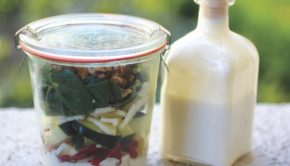Sweet Nostalgia: Celebrating National Dessert Month
Many of us have beloved memories filled with the treasures of the family kitchen—the clanging of baking pans and metal mixing bowls, flour dusted across the counter and the amazing aromas of chocolate, vanilla and cinnamon filling the entire house. That wonderful anticipation of a homemade treat coming out of the oven was pure childhood magic.
“There is nothing better than the smell of home-baked goodies,” says Lynn Feder, owner of Lynn’s Life Breads, an allergen-free bakery. Infused with the best ingredients and dollops of love, desserts are more than just a tasty indulgence. They celebrate long-held family recipes, cultural traditions and the transformative effect of shared pleasures. October is National Dessert Month, a perfect time to explore the history, nostalgia and nutritional gifts of these delicious delights.
From Ancient Times to Modern Bites
Desserts have evolved from simple combinations of fruits and nuts to elaborate confections. The Egyptians, Greeks and Romans enjoyed honey-sweetened treats. By the 16th century, sugar had made its way to Europe from Southeast Asia, paving the way for decadent cakes and pastries. Today, each culture brings unique flavors and techniques to homes, bakeries and confectioneries around the globe.
American Favorites
Beloved for its chewy texture and rich flavor, the chocolate chip cookie was invented in 1938 by Ruth Wakefield, a chef, dietitian, educator and author from Walpole, Massachusetts, who also owned a tourist lodge with her husband Kenneth that they named the Tollhouse Inn.
Brownies originated in Chicago in 1893 at the Palmer House Hotel, where Bertha Palmer asked her chefs to create a portable dessert that could be served at the World’s Columbian Exposition. These cake-like, fudgy squares may contain nuts, chocolate chips or caramel swirls.
Apple pie is synonymous with American culture. With its flaky crust and sweet, spiced filling, it evokes a sense of nostalgia and comfort, and is often accompanied by a scoop of vanilla ice cream. In today’s health-conscious households, ice cream is not made with just cow’s milk. Scrumptious varieties are available featuring milks derived from cashews, oats or coconuts.
“The best ice cream is made from scratch in small batches with fresh, farm-to-table ingredients,” says Chloe Bowman, manager of Tin Cup Ice Cream & Desserts, in Crested Butte, Colorado. “One of our adult favorites is Cookie Monster ice cream made with homemade chocolate chip cookies and all-natural pea flour so it doesn’t make your mouth blue.”
While attempting to recreate a French version, William Lawrence, a New York dairyman, invented the now-classic New York-style cheesecake. It features smooth, rich cream cheese and a graham cracker crust that can be customized with various toppings.
The Sweet Benefits of Desserts
Aside from satisfying our sweet tooth, some desserts come with nutritious benefits. Dark chocolate contains flavanols that help lower blood pressure and fight cell damage, as well as polyphenols that, according to a 2022 study published in The Journal of Nutritional Biochemistry help maintain a better mood. Fruits and nuts are packed with vitamins, minerals and fiber, which play an important role in lowering the risk of heart disease and diabetes. Indulging in a sweet treat may even lead to a sweeter disposition, according to research led by North Dakota State University.
Healthy Alternatives
Dessert time is not always kind to people that are diabetic, vegan, on restricted diets or have gluten sensitivities or allergies to ingredients like eggs, diary and nuts. “I can adapt any recipe to make them delicious and allergy-free. Today, we have so many options,” says Feder, who began baking allergen-free products as a result of her own health issues and allergies.
Dairy substitutes are plentiful in the grocery store, including milk made from oats, almonds, soy, coconut and rice. Alternatives to butter include nut butters, sunflower oil and coconut oil. For those with nut allergies, the texture, taste and nutritional value can be supplanted with rolled oats, granola, crisp rice cereal, pumpkin or sunflower seeds, dried fruits such as raisins or cranberries, or dairy- and nut-free chocolate chips.
For those looking to reduce their consumption of sugar, there are a number of healthier natural sweeteners, including monk fruit extract, raw honey, pure maple syrup, coconut sugar, stevia and blackstrap molasses. Stevia and monk fruit extract are derived from plants and have a flavor very similar to regular sugar. A quick search online will provide guidance on measurement equivalents. Monk fruit, which does not raise blood-sugar levels, can be up to 250 times sweeter than sugar.
Celebrating National Dessert Month
To celebrate National Dessert Month, consider hosting a dessert-themed party where invitees can share their favorite recipes, and be sure to include low-sugar, vegan and gluten-free options, to accommodate everyone’s preferences and dietary restrictions.
Deborah Bevilacqua is a regular contributor to Natural Awakenings.




























